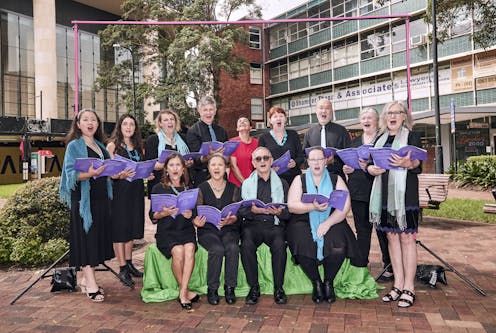how I took portrait photography to the streets of Parramatta
- Written by Cherine Fahd, Associate Professor of Visual Communication in the School of Design, University of Technology Sydney

For the past ten months, I have photographed hundreds of people in the Western Sydney suburb of Parramatta for a portrait project called Being Together: Parramatta Yearbook[1].
The portraits in the yearbook show the people who live, work and play in Parramatta against the backdrop of an ever-changing city[2].
The way a photographer and subject come together to make a portrait is usually invisible in a portrait.
Here, instead of trying to reveal the elusive individuality of a person, I have been focusing on the social dynamics of portraiture – what happens behind the scenes between me and the people I’m photographing.
As Daniel Palmer notes in his book Photography and Collaboration[3], portraiture is by definition relational and collaborative. That is, the process of photographic portraiture inherently brings the photographer and subjects together to arrive at an image.
In the context of this project, coming together for a portrait creates playful opportunities for social interactions among strangers.
It is amazing what strangers will share with me in the space of five minutes.
Two men reveal they are brothers and haven’t seen each other for ten years.
One woman tells me she thinks she’s ugly and asks me to make her look beautiful.
Another keenly describes the floral wonders she is holding from her community garden.
One man whispers that he can’t speak English.
Another tells me he’s in a hurry to go to lunch.
We chat about the everyday things, the weather, COVID, shopping and Rugby League.
There are stories of time spent in jail, and lives being turned around.
New arrivals to Australia speak of their family in lands faraway and citizens who have lived all their lives in Parramatta share insights on the city.
These are the stories photography can’t capture in the silent stillness of the image, but that’s no reason not to continue.
Read more: How the arts can help us come back together again – podcast[4]
Setting up a studio in the street and inviting people to pose together in front of the camera is a thing to see. We always had audiences of passersby watching and it wasn’t long before they were also in front of the camera.
If you look closely at the portraits there are talkative details and warm gestures: micro-movements of the body where people touch each other or hold hands; the spaces between our bodies; instances when we are caught by the camera laughing, chatting and applying lipstick.
I also see myself in action. I am both photographer and subject, a stranger dressed in red, wanting desperately to be with people, to steer them through a photographic moment, to pose and be uncomfortable together.
When people have their portraits made I want to know whether they enjoyed it or found it excruciating and awkward. After the photo is taken, we walk up to the laptop tethered to the camera and look at the photographs. They indicate which portraits they like and hate. I listen and take notes.
Involving people in the selection process creates instant trust.
In bringing people together before a camera, I became acutely aware of photography’s potential to foster social inclusion, social participation, visibility and a sense of belonging and connection to one’s place and people.
Photography is something we all do. It is familiar and familial. Group portraits activate a social encounter and conversation, listening and storytelling.
The social experience of photography is also extended through time. After the photographs have been taken and printed, they are displayed as a collage on a large scale photo wall in the heart of Parramatta in Centenary Square. I love watching people looking for themselves or pointing to familiar faces.
As one passerby declared on seeing the photo wall:
Thanks for treating everyone the same, like we belong and are as deserving of recognition and dignity as others, instead of excluding us from being visible.
This feedback goes to the heart of the project that welcomed people from all walks of life to offer a view of Western Sydney that is far from the media stereotypes.
Fundamentally, the Parramatta Yearbook acts as a model for how cultural institutions and government can work together with artists to record and reflect community, create a sense of belonging and produce narratives about a place in transition that foregrounds the creativity of its citizens ahead of urban development.
Read more: Drawing data: I make art from the bodily experience of long-distance running[5]
The Parramatta Yearbook portraits are on public display in Parramatta’s Centenary Square until October 3, as well as in a 88-page downloadable yearbook[6] from the Museum of Contemporary Art.
References
- ^ Being Together: Parramatta Yearbook (www.mca.com.au)
- ^ ever-changing city (www.smh.com.au)
- ^ Photography and Collaboration (www.taylorfrancis.com)
- ^ How the arts can help us come back together again – podcast (theconversation.com)
- ^ Drawing data: I make art from the bodily experience of long-distance running (theconversation.com)
- ^ 88-page downloadable yearbook (www.mca.com.au)














